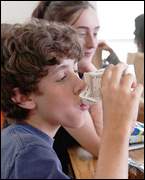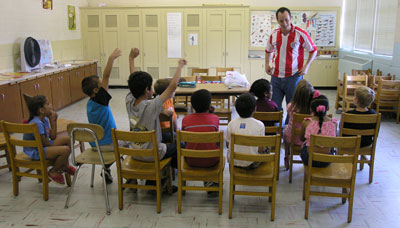
Instructor W.C. Godfrey (
wgodfrey@haywood.edu) is tirelessly spreading the word about Pulp and Paper Technology and all that it encompasses. This new program at Haywood Community College recently hired a new instructor (Reggie Widemon) to continue expansion of course offerings. W.C. received a little assistance this Sunday in the Asheville Citizen Times. The following story explains how novel packaging produced by a local paper products company may help to increase the amount of milk that school age children consume. (
image credit: JFLETCHER@CITIZEN-TIIMES.COM)
A carton too cool for school.
by Mark Barrett, MBARRETT@CITIZEN-TIMES.COM
published June 4, 2006 12:15 am
Blue Ridge Paper Products is trying to make sure schoolchildren do, working with dairy companies to create colorful milk cartons to encourage students to pick up milk in cartons made by the company’s DairyPak division on their way through the lunchroom line.
A promotional campaign the company put together involving milk cartons with a tie-dyed color scheme and the slogan “Xtra Cool!” recently was named the best school milk marketing campaign by the International Dairy Foods Association.
The company signed an agreement with Rupert Boneham, a former contestant on the “Survivor” reality television series known for wearing a tie-dyed tank top T-shirt on the show, to promote the cartons.
Blue Ridge Paper is also a sponsor of a “Milk Rocks!” promotional campaign featuring a concert tour by teenaged singer Britney Christian and has developed a character in a cow suit, D.C. Moo, that appears at events to promote school milk.
Schools and dairies may sometimes have a take-it-or-leave-it attitude about selling milk in lunchrooms, but Blue Ridge decided it had to be more aggressive. The coated paperboard used to make milk cartons account for about 13 percent of total company sales.
Blue Ridge overall has struggled to turn a profit in recent years. Competition from plastic packaging has been one of several factors contributing to losses.
Milk consumption in schools has declined in recent years, said Pamela Parris, director of marketing for Blue Ridge’s packaging division.
“Milk was just not cool anymore,” she said, and milk cartons “have just been so bland and boring” with the designs on some remaining the same for decades.
Blue Ridge and a long-time customer, Prairie Farms Dairy, did a trial a couple of years ago using what the company calls “high graphic” cartons and other marketing steps in St. Louis-area schools and saw milk sales increase an average of 12 percent. Schools that pushed the campaign the hardest —adding new flavors of milk like strawberry or vanilla and using posters or announcements touting milk — sold 34 percent more milk, Parris said.
“It really is the synergistic effect of all those things,” she said.
Roger Gonce of WC&T, an Asheville public relations and marketing firm, designed the tie-dyed cartons.
“Have you ever seen anything more colorful than this?” Parris asked when showing one off recently.
About 75 percent of Blue Ridge’s customers have converted to more colorful packages in a variety of designs. Some have added another color to their cartons or cartoons or puzzles, Parris said.
Some seventh-grade students and the cafeteria manager at Asheville Middle School offered varying opinions of whether snazzy graphics would entice milk drinkers.
Some students love milk, some don’t and few showed any interest in switching.
“I drink it every day,” said student Martel Jackson.
“I hate milk,” said student Danielle Gamble.
Attractive cartons “would be really cool” and might sell more milk, said student Katherine Whatley.
Cafeteria manager Angela Howard wondered.
“Kids either drink milk or they don’t drink milk,” she said.
The cafeteria offers a choice of 1 percent milk, 1 percent chocolate milk, skim milk, juice, water and a frozen drink made from fruit juice. Howard said the school has put up posters of athletes pushing milk, but, “The kids are more interested in the athlete on the poster than what the poster says.”
Cindy Lawler, who is child nutrition director for Asheville City Schools, said schools offer students more choices than when she got into the field 21 years ago and that that may hurt milk consumption.
“We have gone in the direction of being more consumer driven,” Lawler said. “We offer them what they want. When I started, we didn’t offer them options. Milk was it.”
Efforts to make milk more attractive “couldn’t hurt,” Lawler said.
“We try things all the time to get kids to choose healthy options.”
The school system occasionally gets plastic milk containers and they seem to be more popular with students, Lawler said.
But, Parris said, only about 3 percent of schools regularly sell milk in plastic containers — and that dairies using plastic face a challenge because plastic is significantly more expensive than paperboard cartons.
Parris said packaging and other steps cannot persuade every student to drink milk, but the test in the St. Louis area shows marketing and attractive cartons do increase milk consumption.
“Even as adults, we’re attracted by the outside of a package and then we may investigate further. … We’ll only continue to use it if we like what’s inside,” Parris said.
“Our job as packagers is to put something out there that will at least give a child an incentive to pick it up and try it."
 Jim Hamilton and Buddy Tignor spoke to students enrolled in the summer enrichment program at the Pigeon Community Development Center in Waynesville. The children ranged in age from 5 to 10 years-old and enthusiastically embraced the subject matter. Buddy gave a brief lecture on seeds and seed biology (the coconut was a big hit) and Jim introduced the students to forestry via a slide show. He also made yerba mate tea for all of the students to try (another big hit, especially since they got to drink it from the traditional cup made of a cattle horn).
Jim Hamilton and Buddy Tignor spoke to students enrolled in the summer enrichment program at the Pigeon Community Development Center in Waynesville. The children ranged in age from 5 to 10 years-old and enthusiastically embraced the subject matter. Buddy gave a brief lecture on seeds and seed biology (the coconut was a big hit) and Jim introduced the students to forestry via a slide show. He also made yerba mate tea for all of the students to try (another big hit, especially since they got to drink it from the traditional cup made of a cattle horn). Following the lecture we moved outside where all of the students planted bean seeds which they will watch grow over the next few weeks in their classroom.
Following the lecture we moved outside where all of the students planted bean seeds which they will watch grow over the next few weeks in their classroom.





